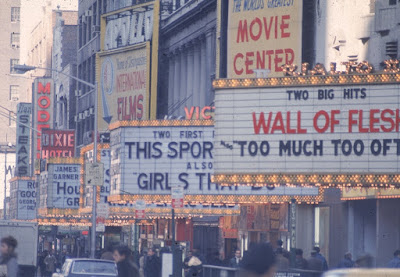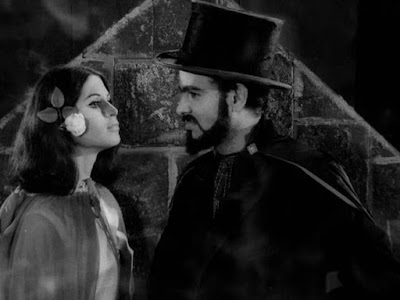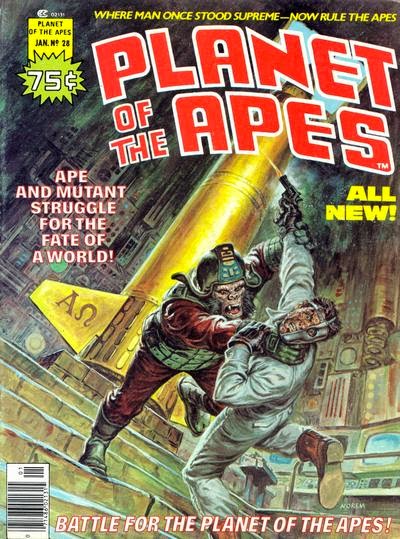AT MIDNIGHT I'LL TAKE YOUR SOUL
1963/Brazil/Directed by Jose Mojica Marins
The films of Brazilian auteur Jose Mojica Marins are the stuff of genuine nightmares. Downbeat, confronting, and bravely flaunting (for its time) blasphemous themes and ideas, they are filled with images that stay with the viewer long after the film has ended, and often linger in the mind a lot longer than you sometimes wish they would. They are perhaps amongst the best unknown masterpieces of horror that the genre has ever produced.
In At Midnight I’ll Take Your Soul, Marins introduced his audience to his most infamous creation, Zé do Caixão - or, in rough English translation, Coffin Joe. Played by Marins himself, Zé is an undertaker in a small, bleak Brazilian town. Looking down with scorn upon religion and people who show emotional weakness, Zé believes that immortality can only be achieved through the “continuity of the blood”, and sets about finding the perfect woman to bear him the male child who will continue his bloodline.
When his own wife Lenita (Valéria Vasquez) is proven to be barren, Zé kills her by having a poisonous spider bite her, then sets about making advances on Teresina (Magda Mei), the fiancée of one of Zé’s few friends, Antonio. When Teresina repels Zé and tells him that Antonio is the only man for her, Zé takes care of this little inconvenience by brutally bludgeoning Antonio and drowning him in a bathtub. Though the townspeople all suspect that Zé is behind the recent deaths, their almost supernatural fear of him prevents them from speaking up, and Zé himself is always careful to cover his tracks and leave no clues behind.
With Antonio out of the way, Zé proceeds with his plan to sire a perfect child, savagely beating and raping Teresina, who later curses Zé, telling him she will commit suicide then return to drag his soul to hell. Zé merely laughs in her face, but Teresina makes good on her threat, hanging herself in her home that night. Though she doesn’t mention Zé in her suicide note, the local doctor suspects his involvement, and ends up getting his eyes gouged out and set on fire as a result.
As Zé’s crimes remain unpunished, he is told by an old gypsy woman that at midnight on the Day of the Dead festival his soul will be taken by the ghosts of those he has murdered. Naturally, Zé scoffs at the gypsy’s curse, but his sins come back to haunt him when he is visited that night by a parade of ghostly apparitions that drive him to the mausoleum where his victims are buried. As the church bells ring in midnight, the villagers converge on the mausoleum after hearing a blood-curdling scream pierce the air, and are confronted by the sight of a horribly disfigured Zé do Caixão, his eyes bulging wide open as if they have been exposed to some unknown horror….
At Midnight I’ll Take Your Soul is truly a remarkable film, filled with tremendously disturbing imagery and exuding a sense of genuine evil that pervades almost every frame. The rudimentary sets, which often resemble little more than a high school stage play, only add to the film’s nightmarish quality. The film is also an aural assault on the senses as much as it is a visual one, with a harrowing melange of sound effects combining well with Salatiel Coelho’s score. The film lets you know from the very beginning that you are in for something quite unlike anything you have seen before, as the aged gypsy lady tells the audience that we should go home while we still have a chance, before eventually pushing a human skull up into the camera and telling us it is now too late to save ourselves.
Of course, it is the work of Jose Mojica Marins - both in front of and behind the camera - that truly make the film the potent piece of work that it is. As Zé do Caixão/Coffin Joe, Marins looks every bit the TV horror movie host, with his black cape, top hat, long sharp fingernails and medallion around his neck. But there is something about his demeanour, his eyes (and the way they fill up with blood when he is enraged), and the way he spits out his dialogue that elevates him above potential kitsch and into something iconic and truly terrifying. But there is also a degree of humour to be found in his character as well, with his face often breaking out into an almost child-like sense of mischievous glee whenever he traumatises or offends the local townspeople. And as co-writer Marins comes up with some memorable dialogue that pokes ridicule and contempt at religion (there’s a great scene where Zé brazenly eats meat in front of a priest on Holy Friday), while as a director he paces the film quite well, makes great use of faces, and certainly knows how to get a genuine reaction from his cast (often resorting to the use of live spiders and snakes to do so).
Though the print quality of the Australian Umbrella DVD release is at times a little rough, it is generally clean and sharp and thankfully doesn’t suffer from the multitude of problems that supposedly befell the print included on the UK box set released from Anchor Bay. Extras comprise of the original trailer and The Making of At Midnight I’ll Take Your Soul, a brief (10 mins) but enjoyable interview with Marins, who recounts the genesis and production of the film in his usual entertaining and laconic style.

THE STRANGE WORLD OF JOSE MOJICA MARINS
Directed by André Barcinski & Ivan Finott
Brazil/2001
Though somewhat short on length (an extra 15 minutes could have been devoted to some uncovered/glossed-over periods) and rather cheaply shot on video, this documentary provides an excellent overview on the life and career of Jose Mojica Marins, with a heavy emphasis of course on the films of his most famous creation, the charismatic and primal undertaker Zé do Caixão/Coffin Joe, the onscreen alter-ego of Marins himself, who went on to become an icon of Brazillian horror cinema and something of a folk hero to the people of Brazil itself.
Via interviews with regular early collaborators such as actor Mario Lima, screenwriter Rubens Lucchetti (whose house resembles a library, with its labyrinth of shelves harbouring neatly stacked movie and pulp magazines), editor Nilcemar Leyart and cameramen Virgilio Roveda and Isaac Floor – as well as input from his aunt Conceircao and son Crounel – The Strange World of Jose Mojia Marins traces Marins’ life as a poor youth growing up in an old movie theatre in Vila Anastacio, an environment which naturally helped develop an intense love of – nay, obsession for - cinema, through to his early filmmaking efforts like the 1958 western The Adventurer’s Fate and 1961’s My Destiny in Your Hands, to the creation and popularity of Coffin Joe. After finding himself under heavy fire from police, politicians and censors in the late-sixties, Marins subsequently struggled to fund projects throught the 1970s, eventually turning to alcohol for solace and hardcore pornography to pay the bills, in a decline which eerily mirrored that of American filmmaker Ed Wood. However, unlike Wood, Marins was able to pull himself through his tough times to enjoy the rennaisance and cult status which his early films received when they were finally released in the US by Something Weird Video in the early 1990s.
Of course, Marins himself is also interviewed at length, wandering around his small apartment cramped with videos and 16mm film cans, showing off his bound collection of Marvel comic books (and dismissing Batman because of the perceived homosexual connotations he had with Robin), and visiting the studios and cinemas of his youth (all of which have been sadly turned into decaying parking lots or garages). Laconic and enthusiastic, and often clutching a cigarette between his long-nailed fingers, Marins reflects back on a career that was creatively rewarding but financially disastrous, discussing his filmmaking techniques (which often involved ingesting substantial amounts of amphetamines to make it through long shooting sessions, and ‘testing’ the resolve of his actresses by having poisonous snakes and spiders crawl over their often naked bodies), and the aura of superstition that often hung over his productions (highlighted by the sudden deaths or serious illnesses of several of his actors and crew members).
Some of the most revealing moments in The Strange World of Jose Mojia Marins are provided by the rare archival footage which the filmmakers have uncovered, including his visit to a Spanish horror film festival in the early- seventies (accompanied by his big, black and bald bodyguard Satan) and an amazing sequence from 1980 where Marins – in full Coffin Joe regalia – conducts an acting class to a large auditorium full of students. Whipping his students into a frenzy as he commands them to imagine that they are aboard an airliner that is about to crash, Marins directs the crowd with the fervour of a revival tent preacher, sweat dripping down his face as his pupils convulse wildly as if in the grip of an exorcism. Incredible stuff, which goes a long way in helping to cement the Coffin Joe myth.
The Strange World of Jose Mojia Marins is available as part of Umbrella Entertainment's 4 disc Coffin Joe box-set.
AWAKENING OF THE BEAST
1969/Brazil/Directed by Jose Mojica Marins
Originally titled Ritual of the Sadists, Awakening of the Beast would not only prove to be the most controversial work of Jose Mojica Marins’ career, but also signaled the end of his most important period as a filmmaker. The film ran into major censorship problems and was effectively shelved for three decades, a disaster for Marins, who relied on the money earned from new film rentals to finance his next work. With his new film effectively sitting unscreened in metal cans, Marins was forced to scrape by on even smaller budgets than usual, eventually resorting to hardcore pornography to eek out a living from the filmmaking medium which he so dearly loved.
Despite the fate which initially befell it, Marins calls Awakening of the Beast his “biggest achievement”, and it’s not hard to see why the film fell afoul of censors and Brazilian law back in 1969 (despite Marins ironically receiving help from the police during production, when they let the filmmaker spend time visiting drug addicts in jail while he was researching the project). Where Marins’ earlier Coffin Joe films were firmly planted in the escapist horror genre (even as they tackled delicate subjects like religion and faith), in Awakening of the Beast he paints a decidedly more grim and realistic portrait of a modern society being corrupted and crumbling under the scourge of widespread drug addiction and loose morality. An inviting postcard of life in Brazil, this isn't.
After Zé do Caixão/Coffin Joe (Marins) bursts forth from his casket amid screams, animal noises and claps of thunder, the opening titles come at us superimposed over pages of the Coffin Joe comic books that were published in the sixties. But any idea that this is going to settle into a standard Marins horror movie goes out the door when the first scene of the film proper depicts a blonde shooting herself up in the foot in the middle of a grotty crash pad, surrounded by a room full of sweaty men who leer on as she strips to a Brazilian anti-war folk song (“War, a word I despise, it cuts deep inside”), and finishes her act off by plonking her bare ass down on a chamber pot!
From here on, Awakening of the Beast becomes almost like an anthology film, as a respected scientist, Dr. Sergio, sits around in a dark, smoky room with several other men (including Marins, playing himself), relating case studies which illustrate the lack of morality amongst the younger generation, with illegal drugs usually shown to be the underlying cause. Often abstract and surreal, one vignette depicts a young girl leaving school and being picked-up by two young men in a VW bug, who bring her back to their flat, where she takes a toke and in true Reefer Madness-style, she instantly goes wild and lets a bunch of strange men stick their fingers up her skirt while they all whistle the theme from The Bridge on the River Kwai! And just when you think the segment couldn’t get any stranger, a Jesus-like figure in robes enters the room and kills the girl in a manner that made me wonder whether Sam Raimi had seen this film prior to writing the ‘tree rape’ scene in Evil Dead (1981). Other segments depict a rich middle-aged lady snorting cocaine and spying on the big black butler as he has his way with her young daughter, and a married woman who commits suicide after having an affair, before the film climaxes with a rather stunning colour sequence as four drug addicted volunteers (all faces from the earlier segments) are given LSD and instructed to stare at a poster for Marin’s The Strange World of Coffin Joe (1968), with each of them having a series of surreal hallucinations.
While it’s always interesting, frequently creative and occasionally confronting and disturbing, Awakening of the Beast sadly lacks the same type of frisson which previous films like At Midnight I’ll Take Your Soul and The Strange World of Coffin Joe delivered in spades. It’s too disjointed to allow you to become completely involved, and Marin’s Coffin Joe character lacks the menace and charisma of his earlier incarnations (by showing him to be a mere character played by Marins, the film takes away some of his menace and demystifies him to a degree). While he may have been a master at conjuring up nightmares, Marins’ seems to possess a rather limited knowledge and understanding of drug addiction, though he is certainly able to make that world look suitably grotty and beautifully ugly (he once again populates his film with an amazing array of unique faces), and much like the ‘Hell’ sequence in This Night I’ll Possess Your Corpse (1967), the colour LSD trip arrives like a psychedelic shock, its lurid gaudiness at complete odds to the stark B&W of the rest of the film, and a perfect example of imagination and creativity triumphing over budget. And it’s certainly intriguing to see the way Marins depicts himself on screen, and the way he ties the Zé do Caixão/Coffin Joe character to the social problems examined in the film, and his cultural impact on the Brazilian psyche.
Not a recommended introduction to the unique world of Jose Mojica Marins, but one which the already converted will certainly want to visit. Umbrella’s release of Awakening of the Beast includes an eight minute interview with Marins, who discusses the origins and making of the film, along with its censorship troubles, and a trailer cheaply put together (primarily with shots of newspaper clippings) for its eventual release after 30 years in the dark.
Both At Midnight I'll Take Your Soul and Awakening of the Beast are available in Australia as part of Umbrella's 4 disc Coffin Joe DVD box set. For the definitive word on Jose Mojica Marins, a copy of Tim Paxton's Monster! International #3 (1993 Kronos Productions) is highly recommended.
Reviews Copyright John Harrison 2015
(Note: these reviews originally appeared on the now-defunct DVD Holocaust website)























